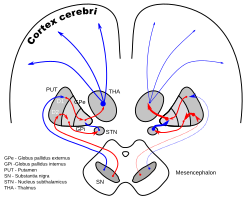Subthalamic nucleus
| Subthalamic nucleus | |
|---|---|

Coronal slices of human brain showing the basal ganglia, subthalamic nucleus (STN) and substantia nigra (SN).
|
|

DA-loops in Parkinson's disease
|
|
| Details | |
| Part of | Basal ganglia |
| Identifiers | |
| Latin | nucleus subthalamicus |
| MeSH | A08.186.211.730.385.800.800 |
| NeuroNames | hier-418 |
| NeuroLex ID | Subthalamic nucleus |
| Dorlands /Elsevier |
n_11/14166739 |
| TA | A14.1.08.702 |
| FMA | 62035 |
|
Anatomical terms of neuroanatomy
[]
|
|
The subthalamic nucleus is a small lens-shaped nucleus in the brain where it is, from a functional point of view, part of the basal ganglia system. In terms of anatomy, it is the major part of the subthalamus. As suggested by its name, the subthalamic nucleus is located ventral to the thalamus. It is also dorsal to the substantia nigra and medial to the internal capsule. It was first described by Jules Bernard Luys in 1865, and the term corpus Luysi or Luys' body is still sometimes used.
The principal type of neuron found in the subthalamic nucleus has rather long sparsely spiny dendrites. The dendritic arborizations are ellipsoid, replicating in smaller dimension the shape of the nucleus. The dimensions of these arborizations (1200,600 and 300 μm) are similar across many species—including rat, cat, monkey and human—which is unusual. However, the number of neurons increases with brain size as well as the external dimensions of the nucleus. The principal neurons are glutamatergic, which give them a particular functional position in the basal ganglia system. In humans there are also a small number (about 7.5%) of GABAergic interneurons that participate in the local circuitry; however, the dendritic arborizations of subthalamic neurons shy away from the border and majorly interact with one another.
The subthalamic nucleus receives its main input from the globus pallidus, not so much through the ansa lenticularis as often said but by radiating fibers crossing the medial pallidum first and the internal capsule (see figure). These afferents are GABAergic, inhibiting neurons in the subthalamic nucleus. Excitatory, glutamatergic inputs come from the cerebral cortex (particularly the motor cortex), and from the pars parafascicularis of the central complex. The subthalamic nucleus also receives neuromodulatory inputs, notably dopaminergic axons from the substantia nigra pars compacta. It also receives inputs from the pedunculopontine nucleus.
...
Wikipedia
